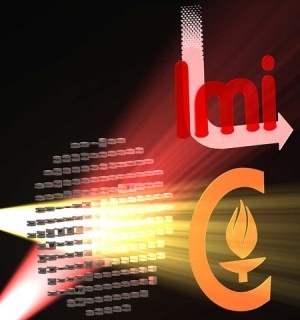Dec 12 2017
Researchers from Caltech have developed an innovative technique for encoding multiple holographic images in a single surface with no dip in resolution. This achievement has changed a long-standing notion that only a single image can be projected from a single surface, irrespective of the illumination angle.
 In a proof-of-concept, Faraon’s team encoded two holograms (of the Caltech logo and the LMI logo) on a single silicon oxide and aluminum surface. CREDIT: Andrei Faraon/Caltech.
In a proof-of-concept, Faraon’s team encoded two holograms (of the Caltech logo and the LMI logo) on a single silicon oxide and aluminum surface. CREDIT: Andrei Faraon/Caltech.
The technology is dependent on the potential of a cautiously prepared surface to reflect light in different ways based on the incident angle at which the incoming light hits the surface.
Holograms are three-dimensional images encoded in two-dimensional surfaces. Upon illuminating the surface with a laser, the image appears to leap out of the surface and is visible. Conventionally, the angle at which laser light hits the surface has been inconsequential; irrespective of this, the same image is rendered visible. This indicates that whichever way we illuminate the surface, only one hologram can be created.
The team headed by Andrei Faraon, assistant professor of applied physics and materials science in the Division of Engineering and Applied Science, created silicon oxide and aluminum surfaces strewn with innumerable tiny silicon posts, where the height of each post is only hundreds of nanometers. (For the purposes of comparison, the diameter of one strand of human hair is 100,000 nm.) The light is reflected differently by every nanopost owing to differences in its size and shape, and depending on the incoming light’s angle.
The above-mentioned characteristic enables each post to function as a pixel in more than one image: for instance, it functions like a white pixel when the incoming light hits the surface at 30° and like a black pixel when the incoming light hits at 0°.
“Each post can do double duty. This is how we’re able to have more than one image encoded in the same surface with no loss of resolution,” stated Faraon (BS ’04), senior author of a paper on the innovative material published by Physical Review X on December 7th, 2017.
Previous attempts to encode two images on a single surface meant arranging pixels for one image side by side with pixels for another image. This is the first time that we’re aware of that all of the pixels on a surface have been available for each image.
Andrei Faraon, Assistant Professor, Applied Physics and Materials Science, The Division of Engineering and Applied Science
As a prototype, Faraon and Caltech graduate student Seyedeh Mahsa Kamali (MS ’17) developed and formed a surface which projected a Caltech logo hologram upon being illuminated with a laser straight on (i.e. at 0°) and projected a hologram of the logo of the Department of Energy-funded Light-Material Interactions in Energy Conversion Energy Frontier Research Center (of which Faraon is a principal investigator) upon being illuminated at an angle of 30°.
The procedure was laborious. “We created a library of nanoposts with information about how each shape reflects light at different angles. Based on that, we assembled the two images simultaneously, pixel by pixel,” stated Kamali, the first author of the paper published in Physical Review X.
By theory, it might even be feasible to encode more than three images on a single surface, despite the fact that there will be basic and practical restrictions at a specific point. According to Kamali, for instance, a single degree of variation in the incident light’s angle possibly cannot be adequate to produce an innovative high-quality image. “We are still exploring just how far this technology can go,” she stated.
Prospective applications of the technology also comprise enhancements to augmented-reality and virtual-reality headsets.
We’re still a long way from seeing this on the market, but it is an important demonstration of what is possible.
Andrei Faraon
The study has been reported in a paper titled “Angle-Multiplexed Metasurfaces: Encoding Independent Wavefronts in a Single Metasurface under Different Illumination Angles.” Co-authors of the study are Caltech graduate students Ehsan Arbabi (MS ’17), Yu Horie, and Mohammad Sadegh Faraji-Dana; and Amir Arbabi from the University of Massachusetts Amherst. The Department of Energy, the Defense Advanced Research Projects Agency, and Samsung Electronics supported the study.